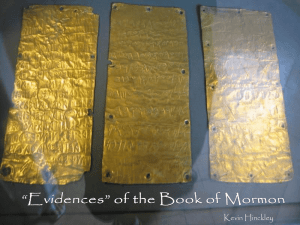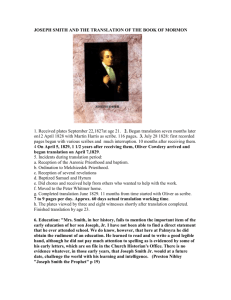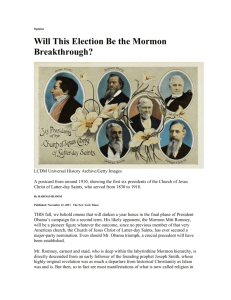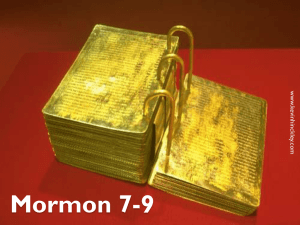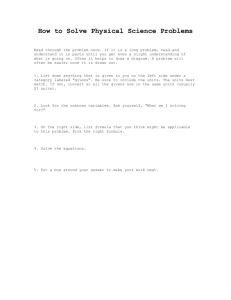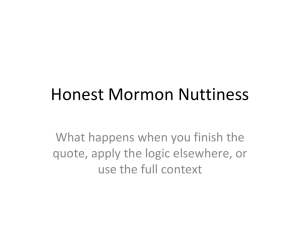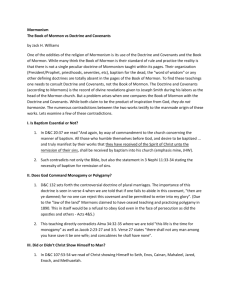new york new york stake conference
advertisement
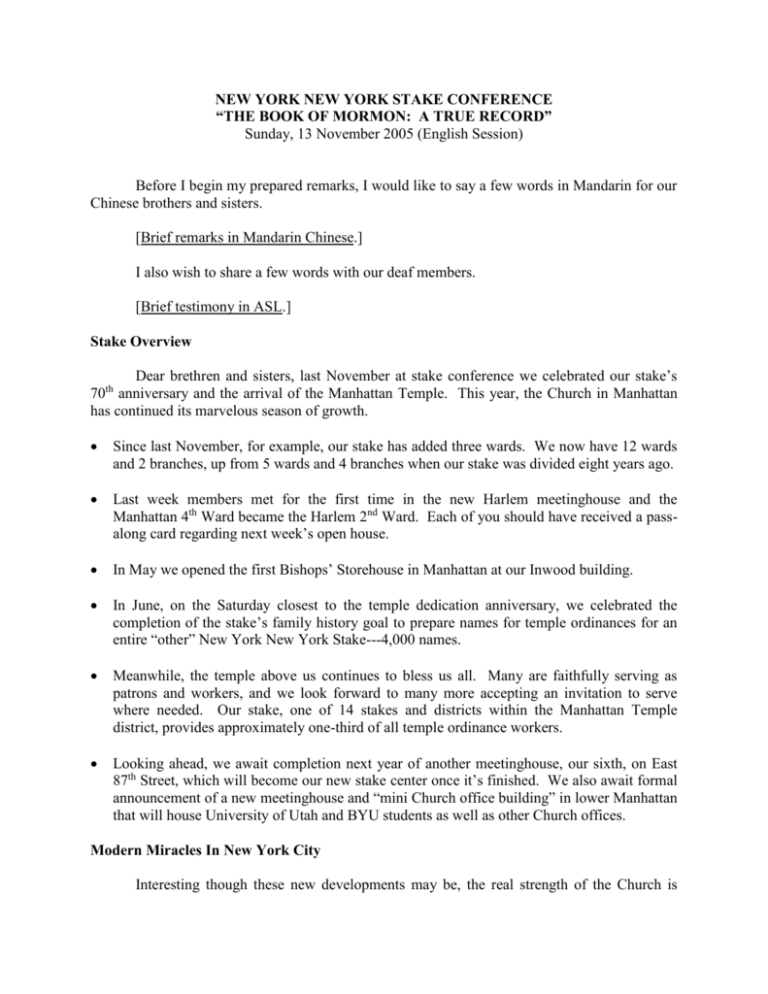
NEW YORK NEW YORK STAKE CONFERENCE “THE BOOK OF MORMON: A TRUE RECORD” Sunday, 13 November 2005 (English Session) Before I begin my prepared remarks, I would like to say a few words in Mandarin for our Chinese brothers and sisters. [Brief remarks in Mandarin Chinese.] I also wish to share a few words with our deaf members. [Brief testimony in ASL.] Stake Overview Dear brethren and sisters, last November at stake conference we celebrated our stake’s 70 anniversary and the arrival of the Manhattan Temple. This year, the Church in Manhattan has continued its marvelous season of growth. th Since last November, for example, our stake has added three wards. We now have 12 wards and 2 branches, up from 5 wards and 4 branches when our stake was divided eight years ago. Last week members met for the first time in the new Harlem meetinghouse and the Manhattan 4th Ward became the Harlem 2nd Ward. Each of you should have received a passalong card regarding next week’s open house. In May we opened the first Bishops’ Storehouse in Manhattan at our Inwood building. In June, on the Saturday closest to the temple dedication anniversary, we celebrated the completion of the stake’s family history goal to prepare names for temple ordinances for an entire “other” New York New York Stake---4,000 names. Meanwhile, the temple above us continues to bless us all. Many are faithfully serving as patrons and workers, and we look forward to many more accepting an invitation to serve where needed. Our stake, one of 14 stakes and districts within the Manhattan Temple district, provides approximately one-third of all temple ordinance workers. Looking ahead, we await completion next year of another meetinghouse, our sixth, on East 87th Street, which will become our new stake center once it’s finished. We also await formal announcement of a new meetinghouse and “mini Church office building” in lower Manhattan that will house University of Utah and BYU students as well as other Church offices. Modern Miracles In New York City Interesting though these new developments may be, the real strength of the Church is found in changed lives and in the faith and testimony of its members. Would all who joined the Church in the last year, over 100 in our stake, please stand. [Pause.] You are the lifeblood of the Lord’s Kingdom. We love you and honor you and welcome you. Now, while you remain standing, would all full-time missionaries serving in our stake please stand, along with all temple and other senior missionaries, and all members currently serving in the temple. Finally, as you stay standing, would all who attended the temple for the first time during the past year, whether for your own endowment or to be sealed for eternity, please stand. Brethren and sisters, look around at some of the Lord’s faithful servants and the fruits of their labors. “The hand of the Lord is over this city.” Thank you. Please be seated. 200th Anniversary of Joseph Smith’s Birth This year we celebrate the 200th anniversary of the birth of the Prophet Joseph Smith and the 175th anniversary of the publication of the Book of Mormon: Another Testament of Jesus Christ. Of the Book of Mormon, Joseph Smith said: “I told the brethren that the Book of Mormon was the most correct of any book on earth, and the keystone of our religion, and a man would get nearer to God by abiding by its precepts, than by any other book.” (Introduction; History of the Church, 4:461.) “In spite of the book’s unparalleled position in American religion,” and “all the attention given to the study of Mormonism, surprisingly little [attention] has been devoted [by non-LDS religionists] to the Book of Mormon itself.” (Givens, p. 6.) One scholar has called the Book of Mormon “perhaps the most religiously influential, hotly contested, and, in the secular press at least, intellectually underinvestigated book in America.” (Givens, p. 6.) “More than any other factor, [the Book of Mormon] ground[s] Joseph’s reputation as seer [or] charlatan, beloved prophet [or] reviled blasphemer.” (Givens, p. 11.) With over 100 million copies of the book having been printed and distributed throughout the world in106 languages, and another 49 translations under way (Boyd K. Packer, “On Zion’s Hill,” GC, Oct 2005), the religion that claims it as sacred scripture and as its “keystone” now stands on the threshold, says one non-LDS scholar, “of becoming the first major faith to appear on earth since the Prophet Mohammed rode out of the desert” of Arabia in the Sixth Century. (Givens, p. 11.) Criticisms Of The Book Of Mormon Even before its publication, the Book of Mormon drew a sharp line between its supporters and detractors. Unable to definitively debunk the message, critics have attacked the messenger, claiming the book to be nothing more than “the imaginative ravings of a rustic religion-maker more inspired by the winds of culture than the breath of God.” (Givens, p. 7.) Those less disposed to believe in the divine, on the other hand, have found intriguing evidences of an authentic ancient text, yet discount the book’s angelic origins because, well, “such things don’t really happen.” (Cf. Givens, pp. 136-37.) Soon after the book’s appearance, detractors proudly hawked something called the “Spaulding Theory,” now long-since discredited, which claimed that Joseph Smith somehow “borrowed” the plot of the Book of Mormon from a separate work written by a Mr. Solomon Spaulding. One still occasionally hears critics refer to this theory, even though the actual Spaulding Manuscript, lost but later found in Ohio in 1884, has practically nothing in common with the Book of Mormon. (Givens, pp. 160-61.) Recognizing the Book of Mormon to be a complex original work, others have searched for textual errors and inconsistencies. For example, some have erroneously claimed that population figures later in the book could not possibly be accurate. Others have ridiculed the book’s references to a few animals that, according to most scientists, did not appear in the New World until the arrival of the Spanish conquistadores, forgetting, of course, that in upstate New York where the book was translated there were no comparable English terms for unique New World fauna like llamas or vicunas or coatis. Still others have criticized the frequent usage in the Book of Mormon of the phrase “it came to pass,” unaware that translators of the King James Version of the Bible translated the Hebrew word “wayehi” as “and it came to pass” but also as “it happened, came, had come, become, arose, was, now,” etc. (Welch, chart 134.) Apparently, Joseph Smith was consistent in translating a certain phrase as “it came to pass,” even if the English Bible’s translators were not. Unfortunately, Mark Twain’s infamous quip about the Book of Mormon being “chloroform in print” (perhaps because he opened the book once and saw the word “Ether”) has gotten wide mileage, serving as an unfortunate if convenient excuse for critics to discount or outright dismiss the book in its entirety, let alone address the substance of its message. As one historian accurately noted: “The Book of Mormon has not been universally considered by its critics as one of those books that must be read in order to have an opinion of it.” (Givens, p. 86.) Evidences In Support Of The Book Of Mormon For every gnat strained at by critics, there are dozens of internal and other evidences in support of the book’s claim to be an authentic ancient record. Even anti-Mormon Fawn Brodie, who actually read the book yet couldn’t quite live its teachings, said: “its structure shows elaborate design, its narrative is spun coherently, and it demonstrates throughout a unity of purpose.” (No Man Knows My History, p. __.) Non-LDS historian Harold Bloom has called the Book of Mormon the product of “an authentic religious genius.” (Givens, p. 11.) As “the most correct of any book on earth,” it is becoming increasingly clear that there is much more within the pages of the Book of Mormon than might first meet the eye. Structure Consider, for example, the Book of Mormon’s complex structure. As a narrative compiled from various sets of records that include several lengthy flashbacks, the book’s “authorship shifts some 2,000 times”! (Givens, p. 156.) It would be very difficult for anyone to dictate such “complex flashbacks and still keep his facts straight.” (Welch, chart 29.) The book also includes detailed military strategies for some 15 major wars (Welch, chart 137), along with remarkably exact depictions of post-war economic slumps and social change; at least 17 recorded legal cases, several with a highly nuanced understanding of the Mosaic law; and a consistent if complex chronology throughout the “reign of the judges,” a period of about 120 years, containing details on the activities of 13 major chief judges of varying ability. Character Development What about the book’s complex character development? Numerous distinct personalities appear within the book. For example, King Benjamin is the only prophet to call Jesus the “Heavenly King,” perhaps because he himself was a king and identified with Christ in a similar way, whereas Alma the Younger uniquely teaches of Christ as the merciful “Good Shepherd,” perhaps in gratitude for Jesus as Savior following his dramatic conversion. (Welch, charts 44, 45.) Even Alma’s three separate conversion accounts, despite later compilation, abridgement, and translation, show a consistent underlying personal voice. (Welch, charts 106, 107.) Computerized wordprint studies, which analyze an author’s stylistic traits much as a forensic scientist examines fingerprints, provide clear evidence that neither Joseph Smith nor any other known contemporaries, including Sidney Rigdon and Solomon Spaulding, wrote the book, concluding that “it does not seem possible that Joseph Smith or any other writer could have fabricated a work with 24 or more discernable authorship styles”, even when Joseph Smith, with his own unique style, was the translator. (Givens, pp. 156-57.) Word Studies The Book of Mormon contains a number of unique personal and place names. Several personal names, including Pahoran and Korihor, although unknown to Egyptologist in 1830, have subsequently been identified as Egyptian. Another 14 names, including Chemish and Muloki, even though they are not found in the Bible, have exact Old World counterparts as evidenced by recently discovered Hebrew inscriptions. (Givens, pp. 119-20, 140-41.) Many phrases in the book sound ungrammatical to English ears but are standard word construction in Hebrew. A few such Hebraisms include, “I dreamed a dream” (1 Ne. 3:2), “rod of iron,” “hear the words of me,” and “cursed with a sore cursing,” where we would more likely say, “I had a dream,” “iron rod,” “hear my words,” and “sorely cursed.” (Givens, pp. 133-35.) Geography One of my favorite personal if minor insights into the authenticity of the Book of Mormon came when studying in Jerusalem over 20 years ago. Reading First Nephi, I was intrigued to come across references, starting in chapter 2, to Lehi and members of his family going “down” from Jerusalem into the wilderness near the Red Sea, and then back “up” whenever Nephi and his brothers returned to Jerusalem in their attempts to obtain the plates of Laban. From Jerusalem to the Red Sea by way of the Jordan Rift Valley, one must descend from 2,600 feet above sea level to 1,300 feet below to the shores of the Dead Sea---literally “down” and “up”---in a distance of about 17 miles. I’ve personally hiked that same route. Nephi’s account mentions this major shift in altitude at least 23 times. All 23 references are consistent internally regarding direction and factually as to elevation. Chiasmus “In an unusually extended and complex example” in the Book of Mormon of chiasmus, a writing style used by many ancient writers, “Alma recounts his miraculous conversion in a 1,200 word narrative, in the course of which 18 word groups are unfolded, then repeated in 18 mirror images with absolutely perfect symmetry. . . . Even the syntactical patterns on one side mirror or develop those of the other, as ‘Do as I have done’ of verse 2 becomes ‘Know as I do know,’ of verse 30.” (Givens, p. 133.) Of the many chiasms in the Book of Mormon, this one from Alma 36, the fulcrum of which is the atonement of Jesus Christ, has been called “one of the finest examples of chiastic composition anywhere in world literature.” (FARMS, __.) Society Although the Book of Mormon predates scientific discovery and exploration of most preColumbian Mesoamerican cultures, it contains remarkable comparisons to that region, as well as an entirely original and workable system of non-decimal weights and measures, references to annual periods of warfare suggesting a predictable seasonal climate, key details on governmental systems, and uniformly plausible life spans. (Welch, chart __.) Symbolism The book also contains deep and rich symbolism far removed from the life of a Nineteenth Century frontier farm boy. Lehi’s vision of the tree of life, with its rod of iron, mists of darkness, and a large and spacious building, taps into a nearly universal cultural motif, whereas the complex allegory of the olive tree, symbolizing the history of the house of Israel, provides details indicating a close familiarity with Mediterranean horticultural practice. Joseph Smith As Translator Of the book’s translator, consider this unflattering portrait of Joseph written by a friend: His only occupation was to plow and cultivate the soil. Because his parents were poor and had to feed a large family, his education was meager. He was able to read fairly well, but his ability to write was very limited and he had only literary knowledge. His knowledge of letters did not go any further. Most of the subjects which were generally taught [then] were completely unknown to him at the time he was favored with a heavenly message. (Givens, pp. 157-58.) Joseph’s wife Emma, who sometimes served as his scribe, was even more blunt: No man could have dictated the writing of the manuscripts unless he was inspired. [Joseph] would dictate to me hour after hour; and when returning after meals, or after interruptions, he would at once begin where he had left off, without either seeing the manuscript or having any portion of it read to him. This was a usual thing for him to do. It would have been improbable that a learned man could do this; and for one so ignorant and unlearned as he was, it was simply impossible. (Givens, p. 158.) “Joseph Smith,” she said, “could neither write nor dictate a coherent and well-worded letter; let alone dictating a book like the Book of Mormon.” (Welch, chart 5.) Analysis of the original and printer’s manuscripts of the Book of Mormon reveals clear evidence of a dictated translation process that would pick up where interruptions left off. Emma recorded that when Joseph “came to proper names he could not pronounce, or long words, he spelled them out.” (Givens, p. 30.) Although there were later minor spelling, hearing, and grammatical corrections made to the translation manuscript, there was never a major editing. Unlike most books ever written, there was no second draft! The translation itself was exceptionally rapid. A recent translator of the Book of Mormon into Japanese, even with an older Japanese version as a guide, was able to complete an average of only one page of printed text per day. Compare that to Joseph Smith’s translation productivity: An average of 7 to 10 pages in today’s printed version per day. (Neal A. Maxwell, notes.) Coincidence Or Providence? Joseph Smith’s a remote frontier world in the late 1820s did not include “mighty cities” with temples, “spacious palaces,” stone towers, roadways, or an agricultural base sufficient to support large populations. At the time of the book’s appearance, Joseph Smith was neither historian, author, archaeologist, anthropologist, sociologist, political scientist, zoologist, botanist, lawyer, economist, geographer, cartographer, demographer, linguist, psychologist, ship builder, metallurgist, Egyptologist, mathematician, warrior, meteorologist, nor scholar of any sort, biblical or otherwise. He was not a trained theologian or translator. He spoke neither Hebrew nor Egyptian nor Mayan or other Native American language. Not well-traveled, he never saw the wadis or wilderness of the Arabian peninsula, nor the ruins of Tikal or Teotihuacan. The native inhabitants he knew wore moccasins and paddled canoes; they did not have differing skin tones or body armor or live in cities or read and write indigenous languages on metal plates. A reader of the Bible, Joseph fully knew that a star guided wise men to the Messiah in Bethlehem yet didn’t attempt to explain away a slightly different sign that appeared somewhere over the Americas of a night without darkness. Neither did he attempt to reconcile known geography with the book’s internally consistent and detailed references to lands, cities, and rivers, trusting that, in time, the record as written would be proven true. Said Joseph: “[T]he Lord has a hand in . . . proving the Book of Mormon true in the eyes of all the people. . . . It will be as it ever has been, the world will prove Joseph Smith a true prophet by circumstantial evidence, in experiments, as they did Moses and Elijah.” (Teachings of the Prophet Joseph Smith, p. 267.) The naked implausibility of gold plates, seer stones, and warrior-angels finds little by way of scientific corroboration, but attributing to a young farmboy the 90-day dictated and unrevised production of a 500-page narrative that incorporates sophisticated literary structures, remarkable Old World parallels, and some 300 references to chronology and 700 to geography with virtually perfect selfconsistency is problematic as well. (Givens, p. 156.) Most authors produce their finest work near the end of their career. For Joseph Smith, the opposite was true: His finest work came at the beginning. After 175 years, where are the draft outlines, the earlier revisions, the made-up word lists, the map doodles? If anything, the passage of time provides more evidences of the book’s truth, not fewer. Joseph never got wealthy off the Book of Mormon. Early supporters and missionaries could barely give the first 5,000 copies away, even though today some 5 million are distributed every year. Joseph ultimately gave his life for the book and the restoration of the Gospel it proclaimed. Whatever one might think of Joseph Smith or the Book of Mormon, the Book of Mormon is, as it declares concerning itself, “a marvelous work and a wonder.” (2 Ne. 25:17; 27:26.) Significance Of The Book Of Mormon For Latter-day Saints, of far greater importance than evidence are the profound, unique, remarkably extensive, and true doctrines contained within the Book of Mormon. Its pages are permeated with prophetic discourses on the fall of mankind, Christ’s atonement, choice and agency, the last days, justice and mercy, the destiny of the House of Israel, the nature of God, the process of repentance, spiritual death, eternal life, resurrection and redemption. Furthermore, the book’s doctrines are consistent with the Bible. As the introduction states, “The Book of Mormon is a volume of holy scripture comparable to the Bible. It is a record of God’s dealings with the ancient inhabitants of the Americas and contains, as does the Bible, the fulness of the everlasting gospel.” “The Book of Mormon,” said President Benson, “was written for us today. . . . It is a record of a fallen people, compiled by inspired men for our blessing today. Those people never had the book---it was meant for us.” (“The Book of Mormon is the Word of God,” Ensign, May 1975, p. 63.) It’s writers “did not intend it to be a history book at all. In fact, Jacob said that his brother Nephi commanded him that he ‘should not touch, save it were lightly, concerning the history of this people’ (Jacob 1:2).” (L. Tom Perry, “Blessings Resulting From Reading the Book of Mormon,” GC, Oct 2005.) “It is,” on the other hand says President Hinckley, “the only book that contains within its covers a promise that by divine power the reader may know with certainty of its truth.” (“A Testimony Vibrant and True,” Ensign, Aug 2005.) Its prime purpose is as witness of the divine role and mission of God’s son, Jesus Christ. Testimony Of Joseph Smith And The Book Of Mormon A testimony of the truthfulness of the Book of Mormon goes hand-in-hand with a testimony of Joseph Smith’s divine appointment as a true prophet. Through Joseph Smith and the Book of Mormon, the Lord heralded a new dispensation on the earth, with living prophets, new scripture, and a message to prepare hearts for His return. In a revelation received shortly after the first printing of the Book of Mormon, the Lord told Joseph Smith: [God] gave him power from on high, by the means which were before prepared, to translate the Book of Mormon; Which contains a record of a fallen people, and the fulness of the gospel of Jesus Christ to the Gentiles and to the Jews also; Which was given by inspiration, and is confirmed to others by the ministering of angels, and is declared unto the world by them—Proving to the world that the holy scriptures are true, and that God does inspire men and call them to his holy work in this age and generation, as well as in generations of old; Thereby showing that he is the same God yesterday, today, and forever. (D&C 20:8-12.) Conclusion Brethren and sisters, I bear witness that the Book of Mormon is a true record, miraculously brought forth in our time for us---as a guide through these last days, as added support of the Bible, and as another testament for “the convincing of the Jew and Gentile that Jesus is the Christ.” (Book of Mormon, Title Page.) “As your Lord and your God liveth it is true.” (D&C 17:6.) I bear witness that there is a God in heaven; that He knows each one of us sitting here today---by name!; that we are His literal spirit children sent to earth with the promise that we might return and live with Him again; that He loves us and desires nothing more than our greatest happiness, here and in the life to come. I bear witness that Jesus Christ is the Son of God. There is “none other name given under heaven . . . whereby man can be saved.” (2 Ne. 25:20; cf. Acts 4:12; D&C 18:23.) I bear witness that Joseph Smith, a true prophet of God, saw God the Father and His Son Jesus Christ; that he ushered in this final age, the “dispensation of the fulness of times” (see, e.g., D&C 128:18, 20), through the gift and power of God; that Gordon B. Hinckley is God’s chosen prophet on the earth today; and that The Church of Jesus Christ of Latter-day Saints is God’s Kingdom, the “only true and living church upon the face of the whole earth.” (D&C 1:30.) May I close with President Hinckley’s challenge: “Without reservation I promise you that if each of you will [read the Book of Mormon], regardless of how many times you previously may have read [it], there will come into your lives and into your homes an added measure of the Spirit of the Lord, a strengthened resolution to walk in obedience to His commandments, and a stronger testimony of the living reality of the Son of God.” (Ensign, Aug 2005, p. 6.) In the sacred name of Jesus Christ, Amen. President Brent J. Belnap
